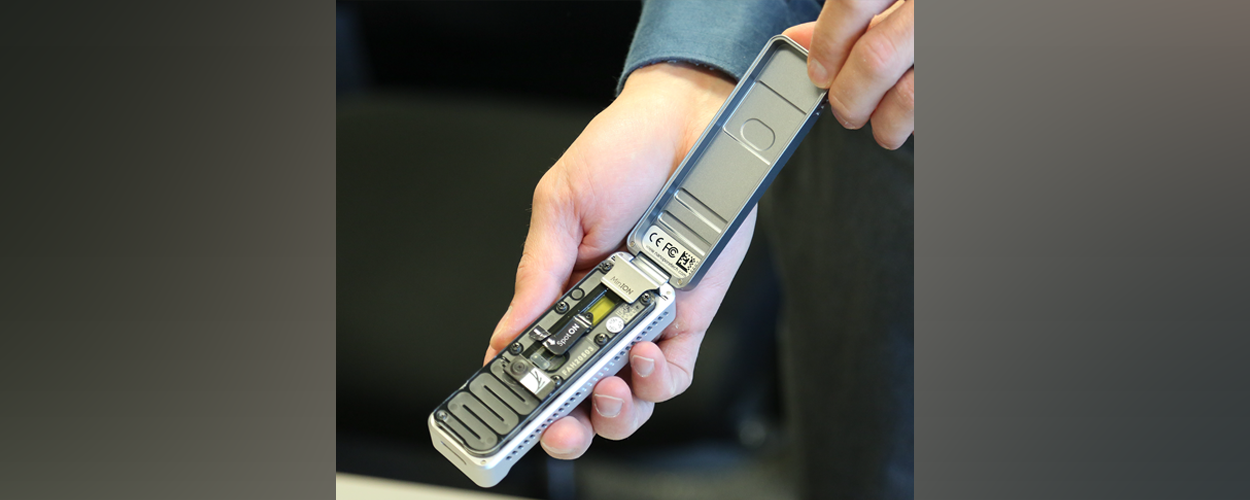Handheld Genomic Sequencer Shows Promise in Field Demo
Handheld Genomic Sequencer Shows Promise in Field Demo
Brad Kroner
The MinION, a handheld genomic sequencer, showed promise in field demonstrations during testing at the U.S. Army Research, Development and Engineering Command Edgewood Chemical Biological Center (RDECOM ECBC)
Owned by Oxford Nanopore Technologies and released to scientists for testing in 2013, the MinION is a DNA/RNA sequencer that the U.S. Army sees as a potential, all-purpose biothreat detector.
“Initially, we imagine being able to use the MinION in conjunction with the current biological detection technologies, but eventually, all we’ll need is the MinION,” said Cory Bernhards, Ph.D., a research microbiologist from the Defense Threat Reduction Agency (DTRA) who conducts research in the BioSensors Branch at RDECOM ECBC.
Not only can the MinION detect known threats, it can sequence unknown threats, too. These unknown biothreats include emerging and genetically modified pathogens.
“There’s no capability right now to detect an unknown biothreat,” Bernhards said, referring to field-deployable detection. “The current technologies are only looking for specific targets.”
By identifying biothreats – known and unknown – on the battlefield, warfighters can respond accordingly to prevent or treat exposure.
Initially, its handheld size proved to be both an advantage and a limitation; while portable, it lacked the ability to produce high quality data in the field. However, ongoing breakthroughs have enabled the MinION to analyze a sample in an hour, without high-powered lab equipment, even in low resource environments, as shown during field tests.
Conducted at Aberdeen Proving Ground and coordinated by the Joint Program Executive Office for Chemical, Biological, Radiological and Nuclear Defense, the field test put the MinION in the hands of operators from the 20th Chemical, Biological, Radiological, Nuclear and Explosives (CBRNE) Command and the 32nd Civil Support Team (CST).
In the field test, there were two bacterial samples, one for the 20th CBRNE Command and one for the 32nd CST. Both operators required just a couple training sessions before successfully using the technology.
“We just did two short training sessions, and by the demonstration, they were able to do it by themselves,” Bernhards said. “You don’t need that much training to do this as long as you have some lab experience. Our goal is to get this to the point where any Soldier can use it with little to no laboratory experience.”
The field test was also conducted completely offline, proving the MinION can work without an internet connection. The demonstration utilized offline bioinformatics data analysis software called “MINDS” which was developed by the Detection Spectrometry Branch at RDECOM ECBC. The MINDS software application provides instant analysis for detection and classification without prior knowledge of the organism in the sample.
“We wanted to make sure that we could do this offline,” Bernhards said. “You’re not going to have a reliable internet signal on the battlefield.”
“They’ve used the MinION in West Africa during the Ebola outbreak, in Antarctica and even on the International Space Station,” Bernhards added. “Obviously, it’s field deployable so we want to get it in the hands of the warfighter so they can use it on the battlefield to identify any biological threat. This can identify any bacterium, any virus.”
Additional projects are planned in the coming months, including one where the MinION will be used to test air filter samples from the New York City subway.
“We’re going to see if the background in those filters would disrupt the sequencing,” Bernhards said, noting that skin cells, hair and microbes will be present. “In the lab, we’ll spike the filters with a known agent and determine at what concentration we can detect that.”
There are still obstacles to overcome before MinION can be fielded.
“What we’ve been trying to do here is simplify the procedures and sample preparation, reduce the required equipment and power, and cut the time down,” Bernhards said. “We’re making good progress, and we have it down to about an hour.”
The goal is to cut the overall time needed to prepare and sequence a sample to 40 minutes.
Oxford Nanopore is soon to release new technologies that will help researchers cut down the process. One is an automated sample and library preparation device that is currently being tested at RDECOM ECBC. Another device coming out at the end of the year will allow fully automated sequencing.
The MinION, a handheld genomic sequencer, potentially has a future with the U.S. Army as an all-purpose biothreat detector.

